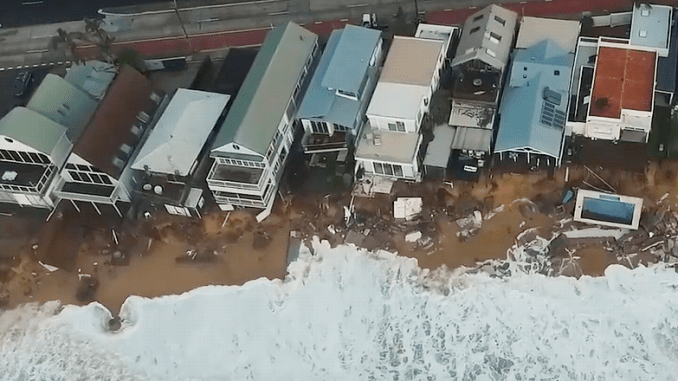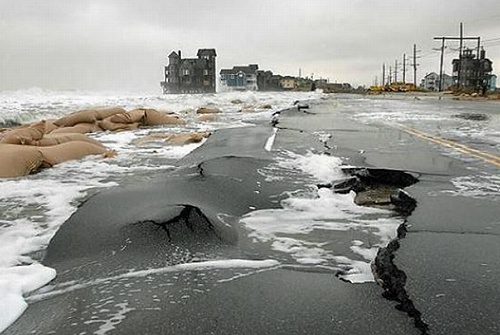
SYDNEY, New South Wales, Australia, May 17, 2022 (ENS) – Climate change is making storms more intense and destructive, but the impact of extreme storms is not wholly negative, an international team of researchers has learned. Sand movements stirred up by extreme weather events could help protect beaches from the impact of sea-level rise by bringing in new sand from deeper waters or from nearby beaches.
Published in the journal “Nature Communications Earth & Environment,” the research study, “A single extreme storm sequence can offset decades of shoreline retreat projected to result from sea-level rise,” was led by the University of New South Wales in collaboration with researchers from the University of Plymouth in the UK, and Autonomous University of Baja California.
The scientists examined three coastlines across Australia, the United Kingdom and Mexico. Each coastline had been subjected to a sequence of extreme storms or extended storm clusters, followed by a milder period of beach recovery.
Australia: Narrabeen Beach
Meanwhile in Australia, researchers studied Narrabeen Beach in Sydney in the wake of a 2016 storm so strong that it tore a swimming pool away from a property overlooking the coast.
Using high-resolution measurements of the beach and seabed, they were able to show that sediment gains at Narrabeen were sufficient to theoretically offset decades of projected shoreline retreat.
Narrabeen is as well known for its top status in Australian surfing culture as it is for rising sea levels due to climate change.
No beach in Australia has been studied more by scientists and fought over by homeowners, beach users and politicians than Narrabeen.
At 2.6km, Narrabeen is Sydney’s second-longest stretch of sand and surf, and it is classified as the beach at greatest risk beach from erosion in New South Wales and the third most at-risk in Australia.
In the published study, the researchers explain that there are so few measurements of the seabeds immediately off of coastlines that it is hard to tell how much sand could potentially be mobilized in the future.
Still, they believe that while these findings are from only a limited number of extreme storm sequences, they potentially change how people can understand the long-term future of coastlines in a warming world.
Dr. Mitchell Harley, senior lecturer from University of New South Wales’ Water Research Laboratory and the study’s lead author, said, “We know that extreme storms cause major coastal erosion and damage to beachfront properties. For the first time we looked not just above water, where the impacts of extreme storms are easy to see, but also deep down below it as well.”
“What we found was that hundreds of thousands of cubic metres of sand were entering these beach systems during these events. That’s similar to the scale of what engineers use to nourish a beach artificially,” he said.
“This could potentially be enough to offset some of the impacts of sea-level rises caused by climate change, such as retreating coastlines, and by several decades in the long-term,” Harley said. “It’s a new way of looking at extreme storms.”
England: Perranporth Beach
In the UK, researchers have studied Perranporth beach in Cornwall, England since 2006, using a combination of monthly beach topographic surveys and quasi-annual bathymetric surveys.
Here, the impact of the extreme 2013/14 and 2015/16 winters resulted in what the researchers called “very significant losses of sand” from the intertidal beach and dune system. However, when looking at the total sand budget, including the underwater part of the beach, they observed that by 2018 the beach had gained 420,000 cubic meters of sand.
Professor Gerd Masselink, who leads the Coastal Processes Research Group at the University of Plymouth, said, “Looking at the extra sand gained by the beach at Perranporth, we are not quite sure whether this has come from offshore or from around the corner, or even both. However, we do now understand that extreme waves can potentially contribute positively to the overall sand budget, despite causing upper beach and dune erosion.”
“We have previously shown that coral reef islands could naturally adapt to survive the impact of rising sea levels,” Masselink said, “and this study shows the changes to our own coastlines could mean the impact of extreme storms are not wholly negative.”
Mexico: La Misión Beach
At La Misión Beach on the Pacific coast of northwest Mexico, a sequence of extratropical storms concentrated over the 2018-2019 boreal winter caused the most severe winter erosion (average = 208 m3/m) since measurements at the site began.

A 2.2-kilometer stretch of this sandy coast has been scientifically monitored monthly since 2015.
Amaia Ruiz de Alegría-Arzaburu, an oceanographer with the Autonomous University of Baja California’s Institute of Oceanological Research, in nearby Ensenada, Mexico, leads the research group at La Mision Beach.
With deep roots in this research group, Dr. Alegria-Arzburu completed her doctorate in oceanography at the University of Plymouth in 2010.
Her research focuses on determining the physical processes associated with the morphodynamics of beaches, based on measurements of hydrodynamics and sediment transport and the application of numerical tools. Her main interest is to determine the resilience of beaches at the scale of storm events, seasons and inter-annual variations.
Predicting Future Shoreline Patterns
Hurricanes have become stronger worldwide since 1980, and the proportion of major hurricanes, Category 3 or above, in the Atlantic Ocean has doubled since 1980 an analysis of satellite data shows.
“The trend is there and it is real,” said James Kossin, a researcher with the U.S. National Oceanic and Atmospheric Administration, NOAA, and lead author of the hurricane study, published in May 2020 in the journal “Proceedings of the National Academy of Sciences.” The researchers suggest that the most damaging U.S. hurricanes are three times more frequent than 100 years ago.

For instance, the extremely active 2020 Atlantic hurricane season had a record-breaking 30 named tropical storms, including 13 hurricanes and six major hurricanes. There were 12 landfalling storms in the continental United States.
This is the most storms on record, surpassing the 28 from 2005, and the second-highest number of hurricanes on record, and 2020 marked the fifth consecutive year with an above-normal Atlantic hurricane season, according to NOAA.
Overall, storm surge levels in Europe are projected to increase on average by around 15 percent by 2100 under a high-emissions scenario. European researchers found that climate change will result in higher seas not only driven by sea level rise, but also by increased storminess. Click here to see this research.
But the three-nation study of beaches in Australia, England, and Mexico found that beaches there could recover from sea level rise with the sand replenishment stirred up by extreme storms.
But can coastal recoveries be predicted with accuracy?
The study’s authors write, “Our results based on unique high-resolution field measurements over three extreme storm-recovery sequences from three different continents highlight the present major challenges of predicting long-term coastal evolution over planning horizons of decades to centuries.”
“Whereas long-term modeling approaches typically assume [that] short-term sediment losses on the subaerial beach and dune caused by extreme storm sequences are balanced by sediment gains in the subaqueous zone – resulting in zero net change in the sediment budget, our results indicate large net positive sediment gains integrated over the entire upper shoreface.”
Click here to read the full study – Harley et al: Single extreme storm sequence can offset decades of shoreline retreat projected to result from sea-level rise, in the journal “Nature Communications Earth & Environment.”
Featured image: A fierce storm batters Sydney, Australia’s Narrabeen Beach (Screengrab from video courtesy University of New South Wales)



